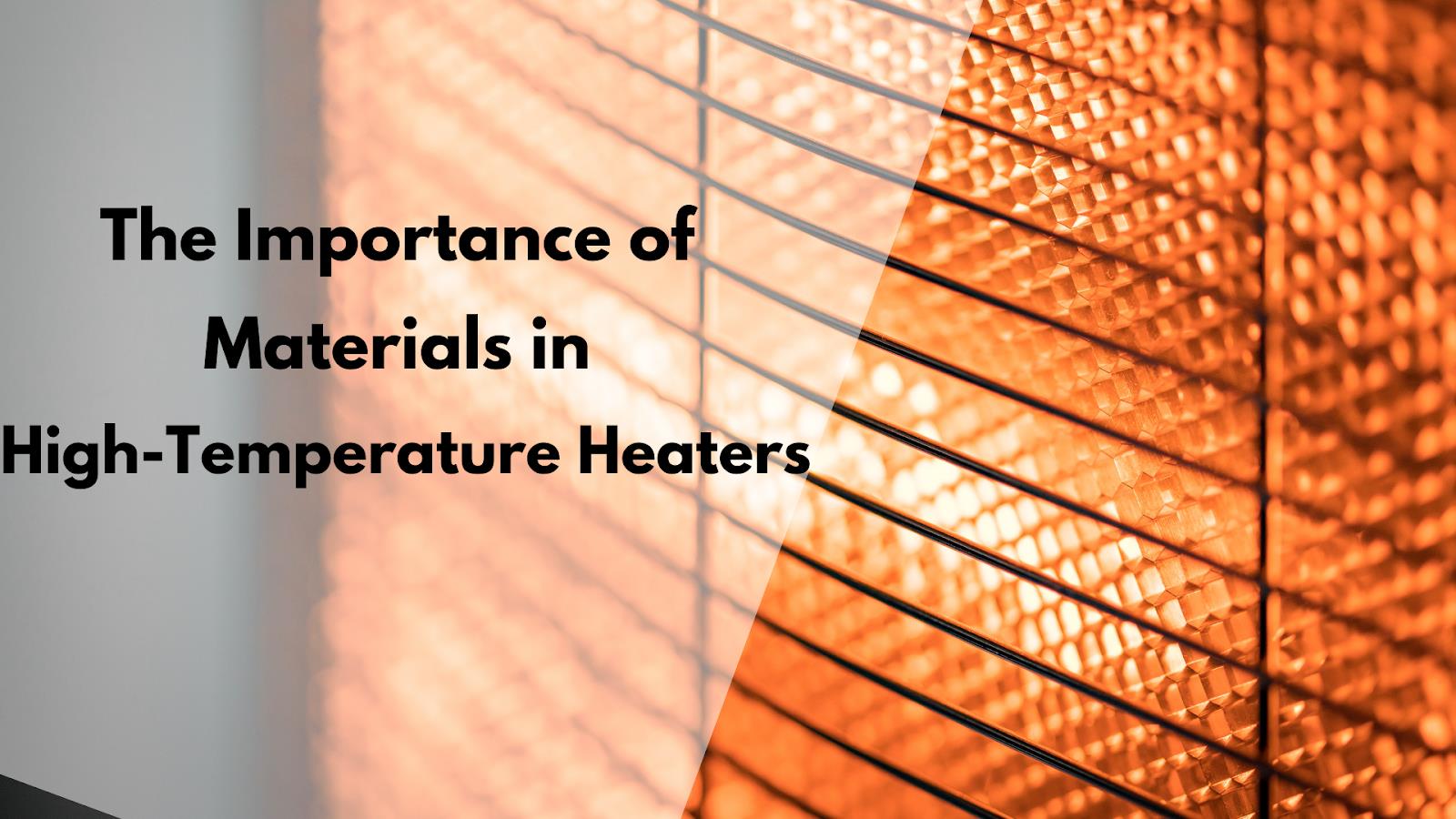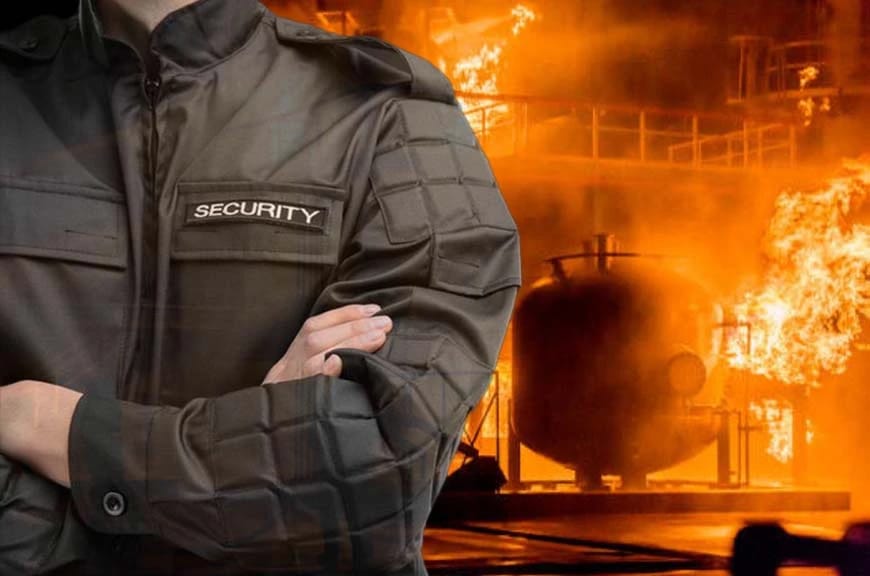The Importance of Materials in High-Temperature Heaters

From the manufacturing and processing industry to the medical and aerospace applications industry, high-temperature heaters are crucial components. The materials used to construct these heaters play a direct role in determining their performance, longevity, and safety.
Research says that High-temperature metallic materials or alloys used in process heating equipment (furnaces, heaters, ovens, kilns, etc.) have a significant effect on thermal efficiency, productivity, and operating cost of the equipment. These materials are used in burners, electrical heating elements, material handling, load support, heater tubes, etc.
Choosing the right materials is imperative to optimize efficiency, reduce failures, and prevent accidents. This article will dive into the critical considerations around high-quality material choices for high-temperature heat custom applications.
How Material Selection Impacts High-Temperature Heater Performance
Choosing the optimal materials is critical for achieving peak efficiency and precise temperature control in high-temperature heating applications. The composition and properties of materials directly influence key performance parameters.
Thermal Conductivity Affects Heat Transfer Efficiency
Thermal conductivity indicates how readily a material conducts heat. Metals like copper and aluminum have high conductivity, while insulators like rubber and wood do not. Higher thermal conductivity promotes faster, more uniform heat transfer in heaters.
It enables efficient energy coupling for rapid heating. Materials with poor conductivity can create hot spots and temperature fluctuations. For instance, graphite offers much better conductivity than stainless steel at high temperatures. Graphite heating elements improve temperature consistency in furnaces.
Thermal Stability Enhances Reliability
A material’s thermal stability denotes its ability to resist changes when exposed to high temperatures for sustained durations. Prolonged heating degrades inferior materials.
Materials with high stability retain their optimal properties over repeated heating cycles.
This enhances reliability and prolongs the heater’s lifespan. Unstable materials degrade progressively, causing deteriorating efficiency and eventual failure. For example, Inconel nickel alloys offer excellent stability at over 1000°C. They outlast stainless steel by over 10X in high-temperature furnaces.
Resistance to Thermal Shock Prevents Cracking
Thermal shock happens when a material undergoes rapid temperature changes, causing differential expansion between surface and core. This induces stresses that can fracture brittle materials. Higher resistance to thermal shock allows heaters to withstand repeated rapid heating or cooling cycles without cracking or catastrophic failures. Robust materials enhance safety and durability.
Ceramics like silicon carbide can endure rapid temperature swings up to 1000°C that would crack conventional ceramics. This makes them ideal for high-thermal-shock applications.
In essence, efficient, reliable, and safe high-temperature heaters need optimized materials. Partnering with expert manufacturers ensures selecting the right composition for each specific use case.
How the Right Materials Enhance Longevity and Safety
Material quality also affects heater lifespan, durability, and accident prevention.
Reducing Failures and Extending Service Life
Inferior materials deteriorate faster under high temperatures:
- Common stainless steel alloys can begin oxidizing above 650°C.
- Nickel-chromium wires become brittle after repeated heating cycles.
- Low-grade ceramics crack due to thermal shocks.
High-performance alloys, composites, and ceramics substantially increase heater longevity. Kapton heating elements, for example, can operate over 100,000 hours at 500°C.
Minimizing Malfunctions and Hazards
Material deficiencies can lead to dangerous malfunctions:
- Contaminated heating elements cause electrical shorts.
- Thermal runaway occurs if heat dissipation is inadequate.
Strict safety standards and proper materials prevent such failures. Silicone rubber heaters offer superb electrical insulation. Advanced ceramics reliably dissipate heat. Robust alloys resist deformation under load. In simple words, the right materials are essential for safe, reliable high-temperature heating.
Overview of Common Materials for High-Temperature Heaters
Various classes of materials are used to construct specialized heaters for different functions and operating environments.
Metals and Alloys
- Nickel-chromium: The most common alloy wire for resistive heating elements up to 1100°C. Provides high resistivity.
- Molybdenum: Withstands over 2000°C. Used for high-watt density heating. Excellent stability in a vacuum.
- Inconel: Nickel-chromium-iron alloy. Resists oxidation and corrosion up to 1150°C.
Ceramics
- Silicon carbide: Withstands 1800°C. High hardness and thermal conductivity. Resists ablation and thermal shock.
- Aluminum nitride: Excellent dielectric properties. Handles rapid heating/cooling cycles.
Composites
- Carbon-carbon: Graphite-reinforced carbon matrix. Resists over 3000°C in an inert atmosphere. High thermal conductivity.
- Ceramic textiles: Woven ceramic fibers offer flexibility and thermal insulation. Used in high-temperature insulation tapes.
Best Materials That Can Be Used for Manufacturing Heaters
Use of Nickel-Chromium (NiCr) Alloys
Nickel-chromium (NiCr) Alloy is used in making heating elements for electric heaters and furnaces.
This is the ideal material for making heating elements. It has a comparatively high resistance making it suitable to convert electrical energy into heat. When the heating element is heated for the first time, it forms a layer of chromium oxide on the outer surface of the heating element.
This layer of chromium oxide works as a protective layer for the heating element and protects the material beneath this layer against oxidation, preventing the heating element wire from breaking and burning out. Heating elements made of Nickel-Chromium (NiCr) Alloy can be used for continuous operation at a temperature of up to 1200°C.
Use of Iron-Chrome-Aluminum (FeCrAl) Alloys
Iron-Chrome-Aluminum (FeCrAl) Alloy is used in making heating elements for electric heaters and furnaces. When a heating element made of Iron-Chrome-Aluminum (FeCrAl) Alloy is heated for the first time, the aluminum in the alloy reacts with the oxygen in the atmosphere and forms a layer of aluminum oxides over the heating element.
This layer of aluminum oxide is an electrical insulator but has very good thermal conductivity. This electrically insulating layer of aluminum makes the heating element shockproof. Heating elements made of Iron-Chrome-Aluminum (FeCrAl) Alloy can be used for continuous operation at a temperature of up to 1400°C. Therefore, it is suitable for making heating elements for electric furnaces used for heat treatment in ceramics, steel, glass, and electronic industries.
Use of Copper Nickel (CuNi) Alloys
Copper Nickel (CuNi) Alloy is used in making heating elements for electric heaters and furnaces, and for making coins.
Copper Nickel (CuNi) Alloy has high electrical resistance, high ductility, and excellent corrosion resistance even at elevated temperatures, which makes it an ideal material for use in electric heaters that require long life spans without maintenance or repairs. Heating elements made of Copper Nickel (CuNi) Alloy can be used for continuous operation at a temperature of up to 600°C.
Use of Platinum Metal
Platinum is an incredible material with high resistivity and melting point. It is very much suitable for electrical heating elements, and rheostats. However, due to its very high cost, its use in electrical engineering is limited to laboratory furnaces with a working temperature of 1300°C, rheostats, and resistance thermometers.
Cost-Benefit Analysis for Heater Material Selection
The materials used in heaters carry both upfront costs and long-term financial implications.
Key Factors to Consider
- Initial material investment: Premium alloys and ceramics have higher upfront costs.
- Operating costs: Better efficiency lowers energy consumption expenses.
- Maintenance costs: Longer-lasting materials reduce repair/replacement costs.
- Safety liability: Preventing failures is financially prudent and socially responsible.
Striking the Optimal Balance
The ideal material choice balances performance gains with affordability:
- While basic Nichrome suffices for a simple workshop furnace, industrial units warrant upgraded alloys.
- Kapton polyimide films provide an economical alternative to costlier mica insulators.
- Silicone rubber flexible heaters offer durability at a fraction of rigid ceramic heater expenses.
With prudent selection, high-quality custom-designed heaters enhance ROI through energy savings, extended service life, and risk reduction.
Final Thoughts
The materials used in high-temperature heating applications directly impact efficiency, durability, safety, and costs. By understanding material science and making prudent selections, engineers can optimize heater performance while balancing affordability. Partnering with specialized manufacturers like Hi-Heat Industries allows the incorporation of custom flexible heaters and custom Kapton solutions to meet specific heating requirements.
With thoughtful choices, manufacturers can keep operations running safely, efficiently, and economically. Now that you know how to choose a heater, get yourselves the best heater right away.
Frequently Asked Questions
1. How do I select the right material for a high-temperature heating application?
Consider the operating temperature range, heating medium (air, liquid, surface), power density requirements, atmosphere (vacuum, gas, moisture), and other parameters. Consult with experienced heater manufacturers to select optimized materials for your specific application.
2. What new materials are emerging for high-temperature heater construction?
Advances in material science are producing innovative options like thermoelectric skutterudites, graphene, and molybdenum disilicide (MoSi2) that extend operational limits. Nanocomposite coatings and thermal barrier layers also boost capabilities. Continuous R&D promises exciting future materials.
3. How do safety standards and regulations impact material choice?
Stringent industry safety standards mandate certain material properties. For example, EN 60335 regulations require silicone flexible heaters for household appliances. Materials must be chosen while adhering to all applicable codes and regulations.



